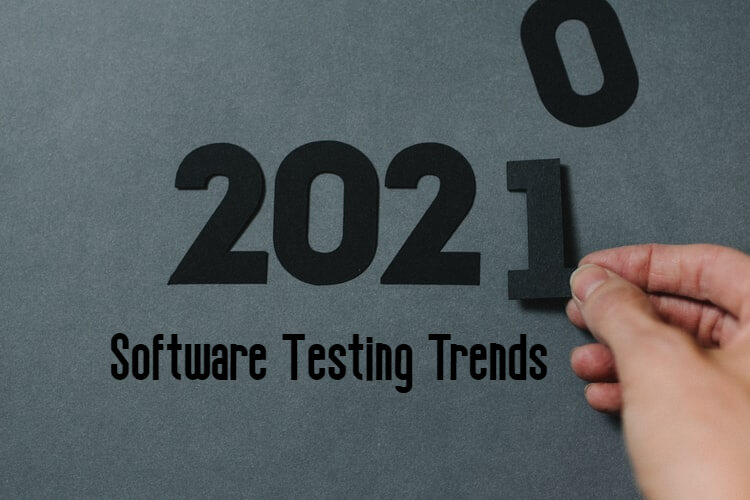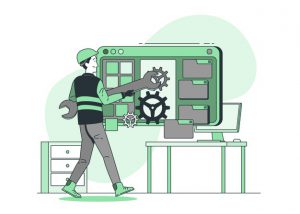In a challenging, fast-paced, and competitive industry, testers need the right infrastructure and tools in place to help them work smarter and pivot quickly to meet customer demand. They have to evolve in sync with the latest trends in software or risk being left behind and ill‑adapted to the new reality.
Undoubtedly, the most common bottlenecks experienced by QA teams are incomplete testing, lack of efficient testing tools, documentation, and environments. Thankfully, 2020 brought remarkable technologies to solve the majority of these problems,
However, as we look forward to 2021, the pressure to innovate amid unrelenting technological progress in the software testing landscape poses an opportunity to rethink the work we do and how we do it. In fact, the impending trends in software testing usher a new wave of enthusiasm among testers and developers alike. How then can you catch up and even prepare your business for the future?
We here at UTOR have our fingers on the pulse. As a professional software testing company, we’re taking time to assess what testing trends leaders should be anticipating for 2021 and beyond. Our analysis encompasses five dominating software testing market trends and five predictions that are likely to redefine industry standards in the future.
Latest Trends in Testing 2021
Below are current testing trends to explore for 2021.
1. Agile Methodology
The future company is expected to be leaner and more Agile and focus better on core competencies to compete in an ever-changing and fast-moving corporate environment.
Agile are methodologies centered around the idea of continuous development, where specifications and solutions advance through cross-teaming and communication. Agile is also one of the fastest adopted trends in testing.
QA teams usually go through progressive stages of testing in Agile aimed at the rapid release of robust products. According to a CollabNet VersionOne report, 97% of organizations embrace Agile methodologies to accelerate software releases.
Opportunities
- DevOps: Agile is now linked to DevOps, and over 73% of organizations prioritize and incorporate this software testing trend into their processes. This practice’s importance is to shorten the SDLC from system development to operations and improve software quality.
- Value Stream Management: VSM is a new but equally essential trend, involving companies’ processes to realize customer needs.
Limitations
QA teams get easily distracted due to a lack of processes
- Shortage in leadership participation
- Lack of experience
- Lack of qualified professionals
2. Test Automation
Test automation testing trends involve the use of tools to aid testing. An InfoWorld survey found that 88% of organizations that automate over 50% of their tests experience faster testing cycles, 71% have increased test coverage, and 68% can capture bugs in time.
As Agile and DevOps adoption rise, more companies are looking to boost their automated testing portfolios.
According to app developer Magazine, there’s been an 85% growth in test automation over two years across every sector. This surge is encouraged by readily available Open Source tools in the market today.
While QA teams know they need to transform their business to remain competitive, they are cautious by culture and are not racing to adopt automation testing services.
Opportunities
- Manual testing complementation.
- Repeated and large-sized projects.
- Artificial Intelligence and Machine Learning.
Limitations
- Lack of expertise.
- Challenges in integrating with DevOps.
3. Test Environments and Data Management
In addition to the challenges related to finding test data, having the appropriate test environment is the most significant setback to continuous testing evolution.
A few of the data management issues are extraction speed and difficult maintenance of different data test versions. In fact, according to a 2019 Continuous Testing Report, 55% of the research participants still spend between %30 to %60 of their test hours on TDM activities.
Some of the solutions to such bottlenecks are for organizations to use test data management tools, observe the GDPR, and focus on data security concerns.
Since teams implement and rely on Agile and DevOps methodologies, with individual concentration for project delivery, the need to apply not merely test automation software but also cloud-based computing — IoT, for example, is ever so apparent.
The Internet of Things, or IoT, means the many physical devices connected to the internet, which collect and share data.
This trend in testing is accomplished through tools that are commonly used for open-source apps. They help monitor tailback between the source and receiver. Hence, IoT resources combined with solutions, persist among major software testing trends to incorporate..
Opportunities
- The introduction of software-based app programs and controllers
- Harmonization of management and operational initiatives
- Virtualization of Service for testing
Limitation
- Scalability of the IoT framework and applications
- Operational problems, such as real-time variability, test sets, and compatibility and accessibility gaps
- Personal information of individuals at risk
PS: Most organizations struggle with adapting to these tools, in addition to continually evolving business requirements. Due to this limitation, the number of defects in testing engagements keeps increasing. And dealing with these costs the testing team’s lots of effort.
4. AI and ML
Custom testing methods allow testers to stick to a checklist to learn about the potential user actions and any possible problems that may surface to be fixed.
But, In 2019, over 25% of senior decision-makers think that AI-driven test execution is a vital orchestration ability.
Complex systems and expanding customers’ demand for obsolete custom testing strategies. They are simply insufficient to keep up with the tech revolutions.
For example, Applitools’s test automation tools were recently integrated with GitHub and GitHub Actions, allowing additional testing tools to join ML algorithms and Visual AI to the DevOps workflow.
The initiative was to facilitate the correlation of code modification across several models of web and mobile application updates. Testing framework and coding will provide the gateway for its achievement.
More teams will depend on AI to test applications in prospect. This dependency would streamline the test automation of all functions without modifying the trunk and its tests. To top it off, developers can better monitor application use cases, ultimately reduce error, and fix root-cause regression issues.
Opportunities
- Visual testing: leveraging imagery technology to test apps look, feel, and performance.
- Differential testing: Using diverse software builds, segmentation of their similarities, and captures the learning derived from them.
- Self-healing automation: Actions such as relying on UI advancements, determining the elements to test, etc.
- Declarative testing: Allows the system to select tests to perform while depending on the intent input in a natural or domain-specific language.
Related: How Can Teams Apply AI and ML in Testing? Use Cases, Tools, and Benefits
Limitations
- High cost and maintenance
- Lack of human resources
- Lack of machine creativity
Here’s a video link to Bython Media’s video explaining the role of AI/ML in testing.
5. Mobile App Testing
According to the Kobiton report, enterprises are ready to allocate more budgets to mobile app testing. About seventy-nine percent noted that they would invest more in mobile app testing in 2021, while another seventy percent want to improve their tester headcount.
The mobile scene is too massive for adequate testing of every OS version, device, and the unification through manual testing. Test automation tools provide for faster test releases and broader test coverage.
This trend in testing is critical in reducing both cost and development time, and, together with manual testing, there is no sign of it slowing down anytime soon.
Opportunities
- Prompt access to DevTools within test sessions
- Geolocation testing to test applications operations in various geographies
- Simulation of different network states using the Throttle Network feature
- Integrations with bug management programs, including Jira, Trello, etc.
Limitations
- The challenges in embracing these mobile app trending in testing still revolve around the small pool of expertise.
- On-premise labs sustenance
- Deficient entree to mobile devices.
- Besides, there are other limitations inherent in mobile testing, such as: screen sizes, connecting types, usability, etc.
PS: Organizations can shorten their test cycles through cloud-based test support, empowering them to concentrate most of their time and resources on the building and delivering sound outcomes in record time.
Future Testing Trend Predictions
So what’s in store for software testing in 2021 and beyond? Check out these 5 trends likely to explode in the following years.
1. HyperAutomation, AI, and ML Engineering at the Heart Testing
As you may be aware, AI and ML are proven gateways to realizing top-notch automation testing. Expectedly, in the coming year and beyond, Machine Learning and Artificial Intelligence deployments will continue across the testing industry.
2. Agile, QAOps, and DevelOps Accelerated Transformation
Agile, QAOps, Develops transformation will speed up. Transformation fastens the delivery of business results. It also brings together lean thinking and automation, aligning collaboration between development and operations. The end goal of which is quality and value optimization.
3. IoT and Edge Computing to Top the Charts in 2021
Edge computing is one of the trends enforced by the COVID-19 pandemic. This form of computing, combined with IoT, will allow organizations to transmit data directly to the cloud for detailed examination and insights extraction.
A considerable amount of bandwidth will be saved through this process, and savings in bandwidth usage, and companies will accrue fewer expenses.
4. Blockchain Testing: Watch out for more Defi apps’ testing
Blockchain application testing gives room to examine defi technology opportunities and its impacts.
Blockchain tech is essential to industries such as finance, automotive, and cryptocurrency. It creates a decentralized network different from a central system used by traditional banks to manage financial operations.
Data removal or changes are not possible on the blockchain. But the technology is readily deplorable and integratable for development teams.
5. Cybersecurity Mesh Testing
Cybersecurity mesh refers to a decentralized architectural technique for robust and adaptable cybersecurity management. Cybersecurity mesh ultimately enables the security perimeter to center on the identity of objects or humans. Testing in this dimension will help determine the scalability and flexibility of systems relying on this technology.
To Sum up
These are the latest trends in testing that are highly useful for businesses and organizations. The developments listed here offer the advanced direction that can drive revenues and customer loyalty up, waste and inefficiency down, and the competition to wonder how they got left behind.
While these software testing trends are likely to evolve continuously, QA teams have to brace up for what lies in the future. Automation and the use of AI are redefining the ways testers conduct their tests. That, however, doesn’t apply not in all cases. Some tests simply can’t be automated. Manual testing is still a crucial test method for QA teams.
But to appropriately leverage both manual and automation testing, you need to know the best time to opt for them. Check out this post for the differences between manual testing and automation testing to understand and compare their usefulness.








